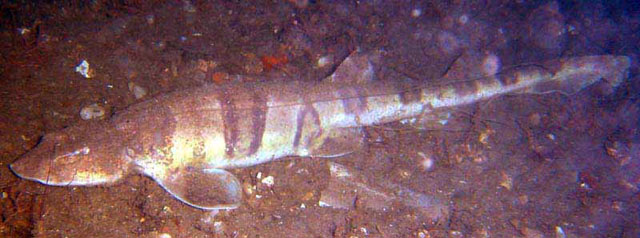Halaelurus natalensis
(Regan, 1904)
Tiger catshark
Classification: Elasmobranchii Carcharhiniformes Pentanchidae
Reference of the original description
Descriptions of three new marine fishes from South Africa. Annals and Magazine of Natural History, (Series 7), 14(80), 128–130
Descriptions of three new marine fishes from South Africa. Annals and Magazine of Natural History, (Series 7), 14(80), 128–130
Image of the original description
No image in first description.
No image in first description.
Synonyms / new combinations and misspellings
Scyliorhinus natalensis, Scylliorhinus natalensis, Scyllium natalense
Scyliorhinus natalensis, Scylliorhinus natalensis, Scyllium natalense
Description :
Citation: Halaelurus natalensis (Regan, 1904): In: Database of modern sharks, rays and chimaeras, www.shark-references.com, World Wide Web electronic publication, Version 12/2025
Please send your images of "Halaelurus natalensis" to info@shark-references.com

Halaelurus natalensis (Regan, 1904), © du Preez, S, www.fish-base.org

Halaelurus natalensis (Regan, 1904), © du Preez, S, www.fish-base.org
Common names
 Pejegato atigrado,
Pejegato atigrado,  Holbiche tigrée,
Holbiche tigrée,  Tiger cat shark,
Tiger cat shark,  Tiger catshark
Tiger catshark
 Pejegato atigrado,
Pejegato atigrado,  Holbiche tigrée,
Holbiche tigrée,  Tiger cat shark,
Tiger cat shark,  Tiger catshark
Tiger catshark
Short Description
A catshark with a prominent upturned knob on the snout, a broad head, and with no spots on the body [536]. Yellow-brown in color, with pairs of broad, vertical, dark brown stripes outlining dusky saddles [536], cream ventrally (Ref. 5510).
A catshark with a prominent upturned knob on the snout, a broad head, and with no spots on the body [536]. Yellow-brown in color, with pairs of broad, vertical, dark brown stripes outlining dusky saddles [536], cream ventrally (Ref. 5510).
Distribution
Southeast Atlantic: Cape Agulhas to East London in South Africa. Until recently, two species were confused under this name, the present one and the recently described Halaelurus lineatus [517]. Source: www.gbif.org
Southeast Atlantic: Cape Agulhas to East London in South Africa. Until recently, two species were confused under this name, the present one and the recently described Halaelurus lineatus [517]. Source: www.gbif.org
Human uses
fisheries: subsistence fisheries; gamefish: yes
fisheries: subsistence fisheries; gamefish: yes
Biology
Oviparous, with 6 to 11 egg-cases per oviduct (commonly 6 to 9) at a time [517]. Egg cases retained until embryos are well-advanced [536]. Feeds on fish, squids and benthic invertebrates [536].
Oviparous, with 6 to 11 egg-cases per oviduct (commonly 6 to 9) at a time [517]. Egg cases retained until embryos are well-advanced [536]. Feeds on fish, squids and benthic invertebrates [536].
Remarks
shark-references Species-ID=2614;
shark-references Species-ID=2614;
Parasites (arranged by Jürgen Pollerspöck)
Cestoda
Cestoda
- Yamaguticestus metini Caira, Bueno & Jensen, 2021 [30556]

















